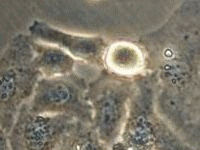
- Image via Wikipedia
Not many things are tougher than dealing with a diagnosis of cancer.
But often the protracted wait for biopsy results, and the uncertainty surrounding them, can be excruciating for patients and their loved ones. Now a research team at the University of Illinois has developed a tissue-imaging technique that produces easily identifiable, color-coded images of body tissue that clearly outline tumor boundaries. What’s more, the process takes less than five minutes.
The team at the University of Illinois, led by professor and physician Stephen A. Boppart, demonstrated the process, called nonlinear interferometric vibrational imaging (NIVI) – a form of microscopy – on rat breast-cancer cells and tissues. Prof Boppart says the process delivers results with more than 99 percent confidence.
Present cancer diagnosis methods focus on visual interpretations of cell shape and structure. Doctors will usually remove a small suspect tissue sample from a patient, add a dye to make the cells more identifiable. Then a pathologist uses a microscope to study the sample, looking for anything unusual. It is then common for another pathologist to be consulted to confirm the findings.
“The diagnosis is made based on very subjective interpretation – how the cells are laid out, the structure, the morphology,” says Prof Boppart. “This is what we call the gold standard for diagnosis. We want to make the process of medical diagnostics more quantitative and more rapid.”
The NIVI differs from the traditional method of identification by assessing and constructing images based on molecular composition. Normal cells have high concentrations of lipids, but cancerous cells have abnormally high protein concentrations, allowing the researchers to easily and accurately differentiate between tumors and healthy tissue – without having to wait for the dye to take effect.


